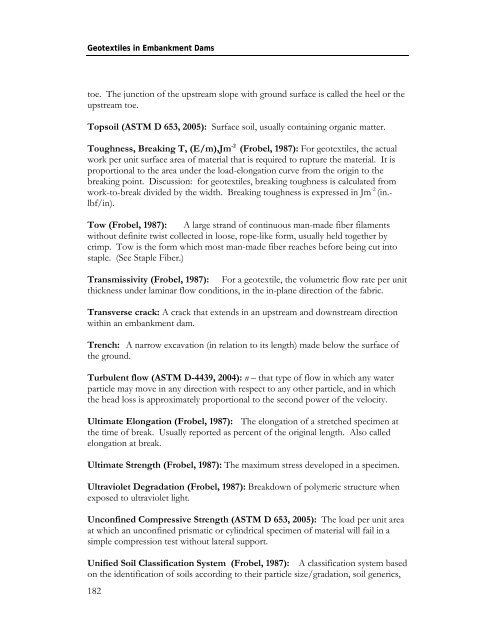Geotextiles in Embankment Dams - Association of State Dam Safety ...
Geotextiles in Embankment Dams - Association of State Dam Safety ...
Geotextiles in Embankment Dams - Association of State Dam Safety ...
You also want an ePaper? Increase the reach of your titles
YUMPU automatically turns print PDFs into web optimized ePapers that Google loves.
<strong>Geotextiles</strong> <strong>in</strong> <strong>Embankment</strong> <strong><strong>Dam</strong>s</strong>toe. The junction <strong>of</strong> the upstream slope with ground surface is called the heel or theupstream toe.Topsoil (ASTM D 653, 2005): Surface soil, usually conta<strong>in</strong><strong>in</strong>g organic matter.Toughness, Break<strong>in</strong>g T, (E/m),Jm -2 (Frobel, 1987): For geotextiles, the actualwork per unit surface area <strong>of</strong> material that is required to rupture the material. It isproportional to the area under the load-elongation curve from the orig<strong>in</strong> to thebreak<strong>in</strong>g po<strong>in</strong>t. Discussion: for geotextiles, break<strong>in</strong>g toughness is calculated fromwork-to-break divided by the width. Break<strong>in</strong>g toughness is expressed <strong>in</strong> Jm -2 (<strong>in</strong>.-lbf/<strong>in</strong>).Tow (Frobel, 1987): A large strand <strong>of</strong> cont<strong>in</strong>uous man-made fiber filamentswithout def<strong>in</strong>ite twist collected <strong>in</strong> loose, rope-like form, usually held together bycrimp. Tow is the form which most man-made fiber reaches before be<strong>in</strong>g cut <strong>in</strong>tostaple. (See Staple Fiber.)Transmissivity (Frobel, 1987): For a geotextile, the volumetric flow rate per unitthickness under lam<strong>in</strong>ar flow conditions, <strong>in</strong> the <strong>in</strong>-plane direction <strong>of</strong> the fabric.Transverse crack: A crack that extends <strong>in</strong> an upstream and downstream directionwith<strong>in</strong> an embankment dam.Trench: A narrow excavation (<strong>in</strong> relation to its length) made below the surface <strong>of</strong>the ground.Turbulent flow (ASTM D-4439, 2004): n – that type <strong>of</strong> flow <strong>in</strong> which any waterparticle may move <strong>in</strong> any direction with respect to any other particle, and <strong>in</strong> whichthe head loss is approximately proportional to the second power <strong>of</strong> the velocity.Ultimate Elongation (Frobel, 1987): The elongation <strong>of</strong> a stretched specimen atthe time <strong>of</strong> break. Usually reported as percent <strong>of</strong> the orig<strong>in</strong>al length. Also calledelongation at break.Ultimate Strength (Frobel, 1987): The maximum stress developed <strong>in</strong> a specimen.Ultraviolet Degradation (Frobel, 1987): Breakdown <strong>of</strong> polymeric structure whenexposed to ultraviolet light.Unconf<strong>in</strong>ed Compressive Strength (ASTM D 653, 2005): The load per unit areaat which an unconf<strong>in</strong>ed prismatic or cyl<strong>in</strong>drical specimen <strong>of</strong> material will fail <strong>in</strong> asimple compression test without lateral support.Unified Soil Classification System (Frobel, 1987): A classification system basedon the identification <strong>of</strong> soils accord<strong>in</strong>g to their particle size/gradation, soil generics,182
















